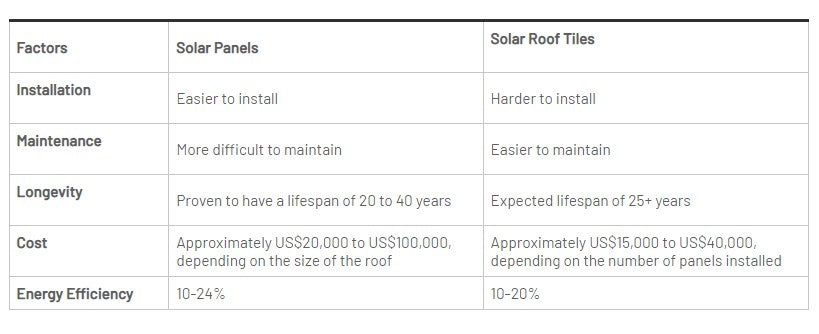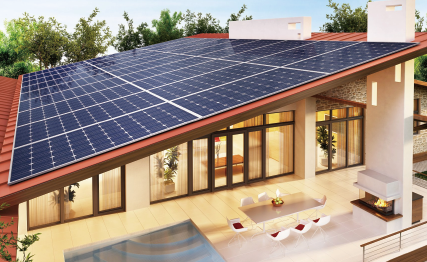Solar roof tiles – A good alternative to the classic photovoltaic system?
Many industry analysts point to solar roof tiles as being the next revolution in photovoltaics. But are solar roof tiles really able to match the output of traditional solar panels? We compare the two to see what the better option is.
Making the choice between installing solar panels or solar roof tiles on a building depends on a range of factors. Cost, aesthetics, efficiency, and durability must be carefully considered.
Solar power has long been touted as a viable alternative to fossil fuels. Lobby groups worldwide point to solar as the cleanest and most readily abundant source of renewable energy. Indeed, solar power use is soaring across the globe. Worldwide solar energy production increased by a record 22 % in 2021. China, the United States, Japan, and India now rank amongst the top countries for solar power capacity. In Europe, the push towards making solar power commonplace has been stepped up thanks to recent measures by the European Parliament. The EU Parliament is currently planning a large-scale roll-out of solar energy in order to remove dependence on Russian oil and gas.
The cost of solar photovoltaic (PV) technology has dropped by more than 80 % during the last ten years. Solar power is now more available and more affordable than ever before. Currently, two types of solar power systems are popular: traditional solar PV panels and the newer technology of solar roof tiles. But which of these options is the most effective? What are the costs involved? Where does the future of the solar industry lie? We take a closer look at the pros and cons of solar panels and solar roof tiles.
Solar Panels – tried and tested renewable energy technology
The history of solar panels begins in 1839 when a young French physicist named Edmond Becquerel first discovered the photovoltaic effect. Becquerel’s rudimentary solar cells, however, were not that efficient. Then in 1883, New Yorker Charles Fritts published a paper titled “On a New Form of Selenium Photocell” in the American Journal of Science. Based on his research, Fritts was able to create a working solar cell using selenium and gold, but only managed a 1 % conversion of sunlight into electricity.
The breakthrough that led to modern solar panels came in 1940 from another American, Russell S. Ohl. Ohl found that silicon was highly efficient in converting sunlight into electricity and produced the first-ever patented solar cell. From Ohl’s remarkable discovery, the solar industry was born.
In 1950, the price of a silicon PV solar cell was an estimated USD 76 per watt, an astronomical sum that made solar technology impracticable. Fast forward to 2021, and the price per watt was listed at just USD 0.20.
The solar panels that we see in use today are made from monocrystalline, polycrystalline, and thin-film panels. Monocrystalline panels are made using one single silicon crystal, whereas polycrystalline solar cells contain numerous crystals fused together. Thin-film solar panels are made by placing incredibly thin layers of semiconductors onto plastic, glass, or metal panels.
- Monocrystalline panels – The first generation of modern solar cells, monocrystalline panels are the most efficient and most widely used form of solar panel. Although it is expensive and resource intensive to manufacture monocrystalline panels, they can achieve between 15 % to 24 % efficiency.
- Polycrystalline panels – Manufacturing polycrystalline panels is simpler and less expensive than producing monocrystalline panels. A cheaper option than monocrystalline panels, polycrystalline solar panels are not as efficient and usually achieve between 13 % to 16 % efficiencies.
- Thin-filmpanels – There are three categories of thin-film solar panels: amorphous silicon (a-Si), copper indium gallium selenide (CIGS), and cadmium telluride (CdTe). While they are the least efficient type of solar panels, thin-film panels are lightweight, highly versatile, and inexpensive to manufacture. Thin-film panels have efficiencies of anywhere between 7 % to 18 %.
Solar roof tiles – a better way to harness the power of the sun?
Many people first became aware of solar roof tiles in 2016 when Tesla released a solar tile in conjunction with SolarCity. However, solar roof tiles manufactured by the Dow Chemical Company had been available on the commercial market in 2005. In fact, solar roof tiles were originally invented by NASA employees in the 1970s and patented by NASA in 1976.
Generally, solar roof tiles have an expected lifespan of approximately 20 to 25 years. Regarding efficiency, solar roof tiles have an average of 10 % to 20 %, with most achieving around 16 % efficiency. Quite a bit less than solar panels. Also, because air cannot easily flow underneath solar roof tiles, they are more prone to overheating and so do not generate as much energy as solar panels.
Solar panels vs solar roof tiles – a comparison
Making the choice between installing solar panels or solar roof tiles on a building depends on a range of factors. Cost, aesthetics, efficiency, and durability must be carefully considered.
If a building requires the roof to be entirely replaced, or it is a new build, then solar roof tiles can be installed for a little more than the cost of a new roof. Solar roof tiles do not impact the look of a building, so they are suitable for historical buildings that must maintain their aesthetics. While less efficient than solar panels, solar roof tiles are still preferable over conventional roofing tiles or shingles. Not all types of roofs, however, are suitable for solar roof tiles. Also, as solar roof tile technology is relatively new on the market, fewer installers may be available.
Conversely, solar panels can be installed on any building without the need to replace the roof entirely. The installation process for solar panels is quicker and much less expensive than installing solar roof tiles. Unlike solar roof tiles, solar panels can be adjusted periodically to maximize their efficiency. The higher efficiency of solar panels means that the installation costs are able to be recouped in less time.

A recent study produced for the University of Engineering and Technology in Taxila, Pakistan, found that although there was considerable domestic consumer demand for a photovoltaic product that had aesthetic appeal, the low efficiency and high cost of installing solar roof tiles were impeding their uptake. Nevertheless, the worldwide solar roof tile market was worth an estimated USD 326.2 million in 2021. By 2031, this figure is expected to reach USD 555.2 million.
As the technology surrounding solar roof tiles continues to advance, it seems inevitable that they will become the preferred photovoltaic option.
To learn more about photovoltaic power generation, please follow SOLARPARTS official website:
Twitter: Solarparts Instagram: Solarparts
Tumblr: Solarparts Pinterest: Solarparts
Facebook: Shenzhen Solarparts Inc
Email address: Philip@isolarparts.com
Homepage: www.isolarparts.com





